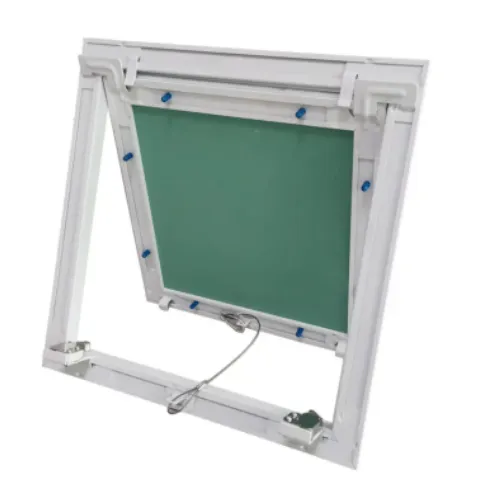- Afrikaans
- Albanian
- Amharic
- Arabic
- Armenian
- Azerbaijani
- Basque
- Belarusian
- Bengali
- Bosnian
- Bulgarian
- Catalan
- Cebuano
- Corsican
- Croatian
- Czech
- Danish
- Dutch
- English
- Esperanto
- Estonian
- French
- German
- Greek
- Hindi
- Indonesian
- irish
- Italian
- Japanese
- Korean
- Lao
- Malay
- Myanmar
- Norwegian
- Norwegian
- Polish
- Portuguese
- Romanian
- Russian
- Serbian
- Spanish
- Swedish
- Thai
- Turkish
- Ukrainian
- Uzbek
- Vietnamese
aug . 08, 2024 15:05 Back to list
Innovative Designs for Ceiling Trap Doors Enhancing Space Accessibility and Interior Functionality
The Enigma of Ceiling Trap Doors A Hidden World Above
Ceiling trap doors, often overlooked yet fascinating architectural features, serve as portals to the unknown. Found in various structures—from historic homes to modern buildings—these unassuming doors hold stories of mystery, practicality, and creativity. They represent a functional yet often concealed aspect of architecture that can transform the way we perceive space and accessibility.
Historical Significance
Historically, ceiling trap doors were integral to the design of many homes and public buildings. They allowed for the efficient use of vertical space, providing access to attics, lofts, or storage areas that might otherwise remain unused. In ancient times, these trap doors often served practical purposes, such as allowing tradespeople to deliver goods or supplies without infringing upon the space within the main living area. In some grand estates, they were cleverly designed to facilitate the movement of household staff or to conceal valuables.
Moreover, ceiling trap doors have played a role in constructing hidden rooms or secret passages, adding an element of intrigue to a building's design. The play between light and shadow, accessibility and secrecy, can create a dynamic experience for anyone who enters a space equipped with these architectural marvels.
Practical Considerations
In modern homes, ceiling trap doors continue to be valued for their practicality. They are often installed as access points to attic spaces, enabling homeowners to store seasonal items, holiday decorations, or excess belongings out of sight. This clever use of vertical space not only keeps homes organized but also contributes to efficient heating and cooling, as unused attics can act as insulation zones.
Additionally, ceiling trap doors can improve safety. In certain designs, they provide access to mechanical systems like HVAC units, making maintenance easier and more efficient. The integration of trap doors into home design reflects a deeper understanding of functionality, emphasizing the importance of accessibility in modern living spaces.
ceiling trap doors

Creative Expressions
Beyond their practical applications, ceiling trap doors also offer opportunities for aesthetic expression within interior design. Contemporary designers are embracing these elements to create unique experiences in homes and commercial spaces. By incorporating artistic touches, such as intricate woodwork, glass features, or playful colors, they can transform a standard trap door into a statement piece.
Furthermore, their potential for creativity extends into unconventional settings. In themed restaurants, art galleries, or museums, ceiling trap doors can serve as imaginative apertures leading to surprise mini-exhibits or hidden seating areas. This playful approach can enhance engagement with visitors, invoking curiosity and exploration.
Cultural Impact
The allure of ceiling trap doors is not confined to functional design or historical value; they also permeate popular culture. Often depicted in films, literature, and folklore, trap doors symbolize secrecy, adventure, and the unknown. From the secretive chests in pirate stories to the hidden chambers in fantasy tales, trap doors have captured the imagination of generations, evoking a sense of wonder and excitement.
As the world continues to evolve, the role of ceiling trap doors may change, yet their intrinsic appeal remains timeless. They invite us to look upwards and consider the possibilities that lie beyond our immediate view. Whether as practical storage solutions, artistic expressions, or symbols of mystery, ceiling trap doors invite exploration and curiosity, reminding us that sometimes, the best-kept secrets are just above our heads.
In conclusion, ceiling trap doors are more than functional elements; they embody a unique blend of history, utility, creativity, and mystery. As we appreciate these hidden features, we not only acknowledge their contribution to architecture but also the stories they continue to tell about the spaces we inhabit.
-
Transform Interiors with PVC Gypsum Ceiling: A Stylish, Durable, and Moisture-Resistant SolutionNewsMay.19,2025
-
The Smart Interior Upgrade: Discover the Durability and Versatility of Gypsum Ceiling Access Panel SolutionsNewsMay.19,2025
-
The Smart Choice for Interior Design: Discover the Value of PVC Gypsum Ceiling SolutionsNewsMay.19,2025
-
Mineral Fiber Ceiling Tiles: The Smart Blend of Performance and AestheticsNewsMay.19,2025
-
Mineral Fiber Ceiling Tiles: The Superior Choice Over Gypsum for Sound and Fire SafetyNewsMay.19,2025
-
Mineral Fiber Ceiling Tiles: Eco-Friendly Strength and Style for Every CeilingNewsMay.19,2025







